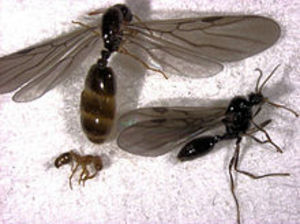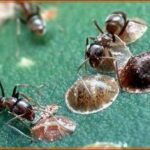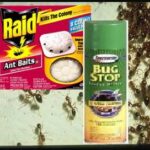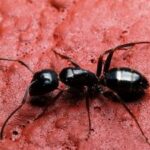The red imported fire ant (RIFA) is native to South America. During the 1930s, some stowed away on some shipments from Brazil and escaped into North America. They have become a major nuisance in the south and western United States because of their painful stings. They have recently been discovered in Australia. The only way to kill off a fire ant colony is to kill the egg-laying queen. Even the easiest way of doing this, called the two-step method, requires considerable preparation and effort.
Step One: Laying Baits
Fire ants live in colonies where workers bring food in and share them among other members of the colony. The all-important queen is so large that she needs to be fed by workers. One big advantage of using commercial fire ant baits is that the ants bring the poison-laden food into the colony. Eventually the queen eats the food, which is often corn meal mixed with pesticide.
Baits cannot be strewn about anytime. They need to be laid at the time when workers are most likely to find and gather the tainted food. It is best to use baits in the fall or spring when the mornings are cool and dry. Make sure no rain is expected for at least eight hours, or the bait will be washed away. The first worker ants should reach the bait in about a half hour or less.
North Carolina State University points out that even after the queen dies, workers will still continue on as best they can for several weeks. Baits take longer to work than many other methods of controlling fire ants, but they eventually can kill a queen. Another advantage is that baits can be laid without risking the collective anger of the colony.
Step Two: Drenching Mounds
This is a far more dangerous process than laying baits because fire ants will swarm suddenly onto any perceived threat to their colonies – including people. Be sure to wear closed-toe shoes, long pants and long socks in order to reduce the chance of getting fire ant stings. Although there are many commercial fire ant drenches available, always check with your local officials to be sure the chemical is not regulated. If it is, then a professional exterminator must be hired.
Drenching also should be done in fall or spring cool mornings when the workers are closest to the surface where it is warmer. By the afternoon, the top of the ground is too hot and the ants will move to the deepest parts of the colony, making the drench useless. The drench must be poured slowly right on top of a fire ant mound. Using the liquid to collapse the opening is recommended. The larger the diameter of the mound, the more drench is required. Use one gallon of drench for every six inches that the mound is estimated to be.
The drench will not kill all of the fire ants immediately. Any surviving ants will flee and try to establish another colony about fifteen feet away. On a week, these mounds will appear and can also be drenched.
Sources
Desert Museum. “Red Imported Fire Ant.”
North Carolina State University. Red Imported Fire Ant in North Carolina.” Charles Apperson and Michael Waldvogel.
Living With Bugs. Fire Ant Control.” Jack DeAngeles, PhD.







